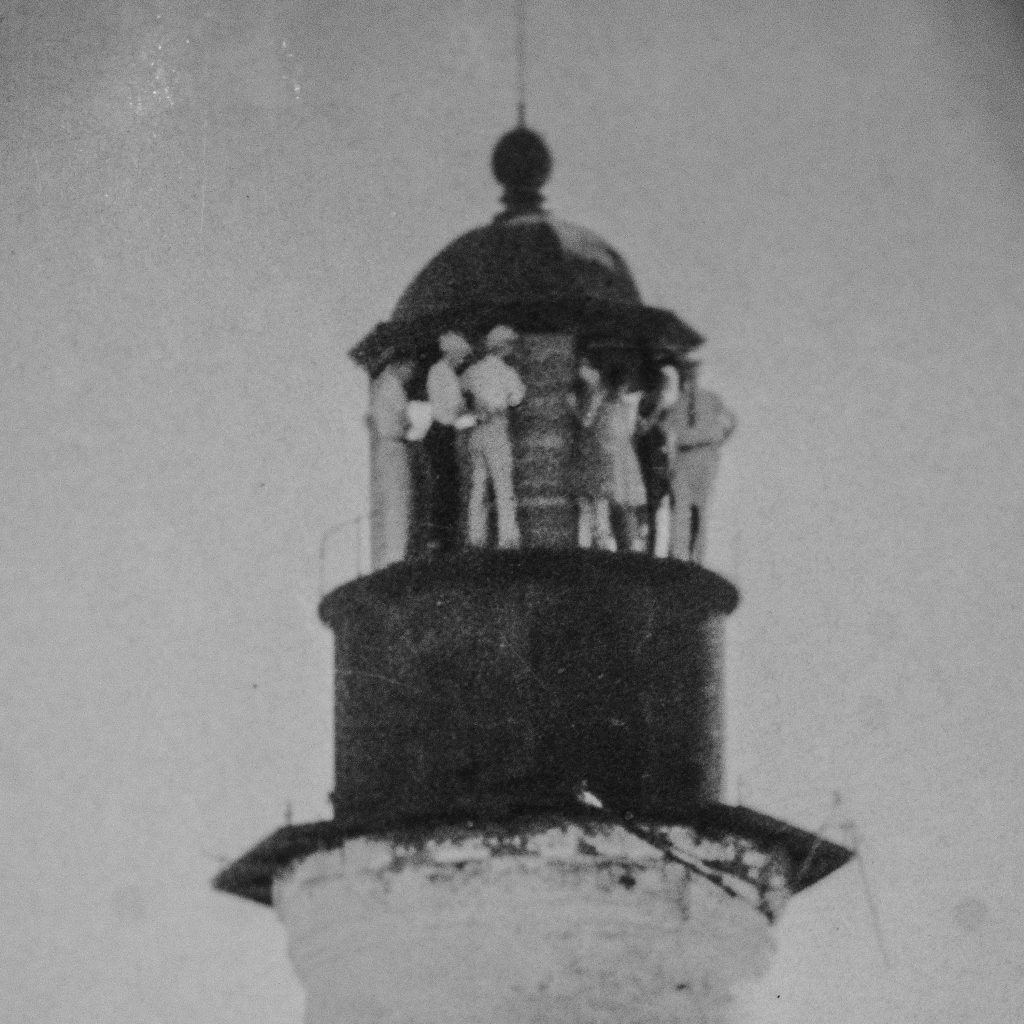
What is happening here?!
Visitors have clambered to the top of Point Isabel Lighthouse, to the very top, in the lantern room, on the outside catwalk. They have quite literally stepped through the frames of the windows in the top of the lighthouse and gathered around an exciting message from the Port Isabel Townsite & Development Co. It is 1927.
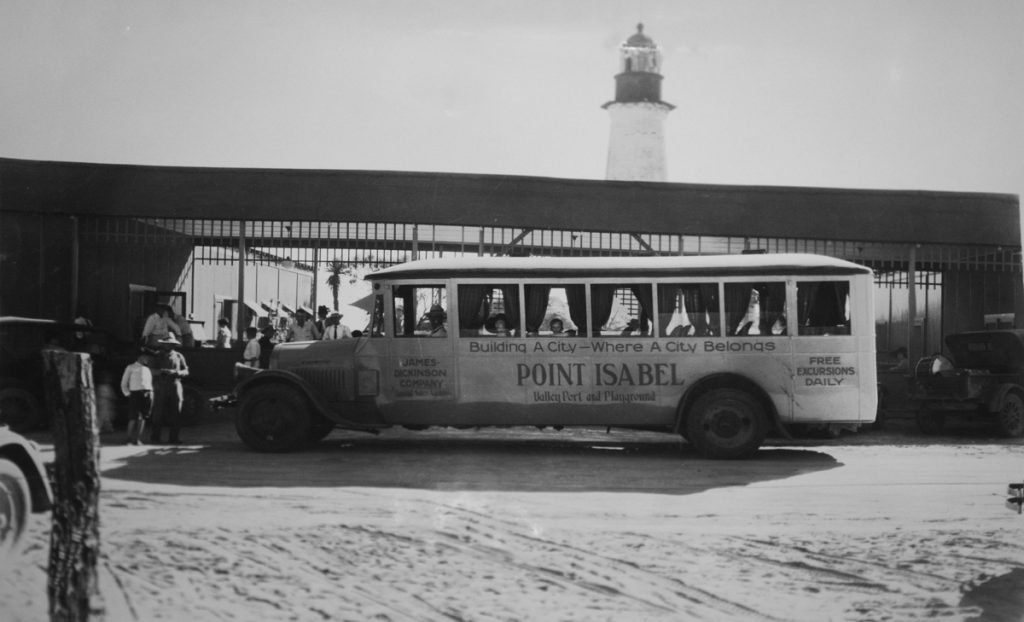
How did they get here?
The James-Dickinson Co., Realtors customized buses emblazoned with a bold message… “Building A City — Where A City Belongs”, POINT ISABEL, Valley Port and Playground“. With free excursions daily from points in the west end of the Rio Grande Valley, buses arrived in Port Isabel loaded with potential buyers. Some of which are pictured in the very top of the Lighthouse.
Where did these visitors come from?
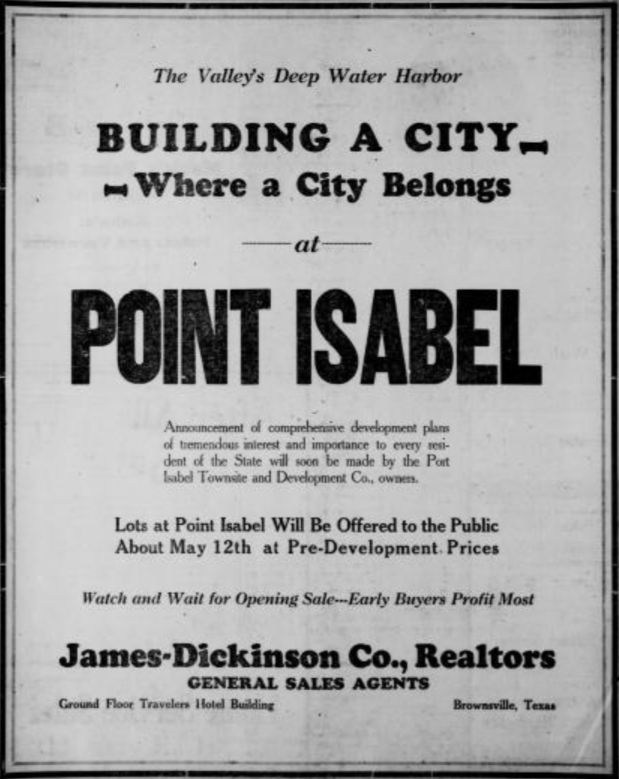
Ads like this one ran in newspapers across the state of Texas. “Announcement of comprehensive development plans of tremendous interest and importance to every resident of the State will soon be made by the Port Isabel Townsite and Development Co., owners.” Excursions were offered to bring interested parties to the Rio Grande Valley and then to Port Isabel.
The interest must have varied as shown by the look on this woman’s face still seated in the bus. She’s and her bus-mates have traveled from Harlingen, Mission and McAllen. Unpaved roadways were dusty, the bus was not airconditioned, and windows were cranked down. (Zoomed in view from the Excursion Bus image above.)
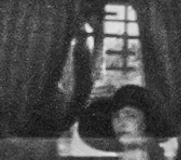
BACKGROUND on “Building A City — Where A City Belongs”
The Port Isabel Company purchased the entire townsite, all 800 acres. Its abstract of title reached back to the 1772 “Espiritu Santo Grant”, when Salvador de la Garza applied for the tract of land. De la Garza became grantee in 1781 of Potrero del Espiritu Santo (Pasture of the Holy Ghost), made up of nearly 300,000 acres in Cameron County. A Point Isabel 1875 plat was adopted in 1927 when the Tyrrell’s envisioned the Valley’s Port and Playground. 155 years after De la Garza’s grant application, work begins in earnest on “Building A City Where A City Belongs”.
What was Point Isabel before it was a “CITY”?
The “Point” as it came to be referred to, was the destination for the Indigenous during oyster and “tuna” (prickly pear blossom) seasons. The area also served as ranch land for cattle owners who lived in Matamoros. In 1846, Zachary Taylor brought 4,500 troops the area, carved out earthen embankments and called it Fort Polk. By 1850, the fort was abandoned and the site was selected for the location of a lighthouse. Generations of settlers at the point fished and lived and maneuvered around Indigenous migration, cattle ranching, military operations (through the US-Mexican War; Civil War and the Mexican Revolution) and settlement by U.S. Customs and the Point Isabel Lighthouse. Relocated multiple times, locals found themselves once again gentrified. “The straggling array of small houses and huts which formerly constituted the greater part of the town have been moved back several blocks from the water front, and arranged in an orderly manner in that section of the city in which homes of that type will be permitted. Well graded streets, leveled and drained, now traverse many of the sites where these huts formerly stood.”1
The townsite was buzzing with equipment, three dragline dredges, forty teams, tractors of all sizes, scrapers, the dredge “Ben” and hundreds of laborers. The Port Isabel of today was carved out of the clay banks of the Point. Channels were dug, a yacht basin fashioned and deepened, earth moved to fill ravines and paths worn by 150 years of pedestrian traffic were erased. Streets were organized, lots leveled and 4,000 palm trees planted– two per lot. Seventeen blocks of streets were curbed and concreted.
Where are they now?
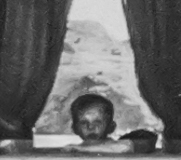
This young boy was seated behind the lady pictured above. Part curious and part resigned, he is not among the gaggle at the top of the Lighthouse, perhaps was never destined to be as he wouldn’t be making any real estate deals for a couple of decades. He can sit in his window seat and safely enjoy the sea breezes.
Point Isabel became Port Isabel when the townsite incorporated on March 23,1928. Just 5 years later, in 1933, the area was heavily damaged by a series of storms and hurricanes. Sportfishing was identified as prime attraction to the area and the Tarpon Rodeo is created in 1934. Heavily promoted across the country it will celebrate 85 years in 2025. The first Queen Isabella Causeway is constructed in 1952, connecting South Padre Island to the mainland. And just two decades later the second causeway is built. Port Isabel continues to grow in popularity as a tourist destination and will mark a centennial in 1928. The Lighthouse will celebrate 175 years in 2027-2028. “Building A City Where A City Belongs”? A century later might just prove that. A city that was built around an immovable lighthouse.
Author: Valerie D. Bates
Sources & Credits
Photo credit: Harlingen Public Library Archives.
Image credit of advertisement: The Portal to Texas History
All research on “1927” in this post is publicly available at this link: https://texashistory.unt.edu/search/?q=%22port+isabel%22&t=fulltext&sort=&fq=str_year%3A1927
1 Vision Which Held Valley Together Materializes https://texashistory.unt.edu/ark:/67531/metapth1379791/m1/22/zoom/?q=%22port%20isabel%22&resolution=3&lat=7689.499999999999&lon=2968.999999999999